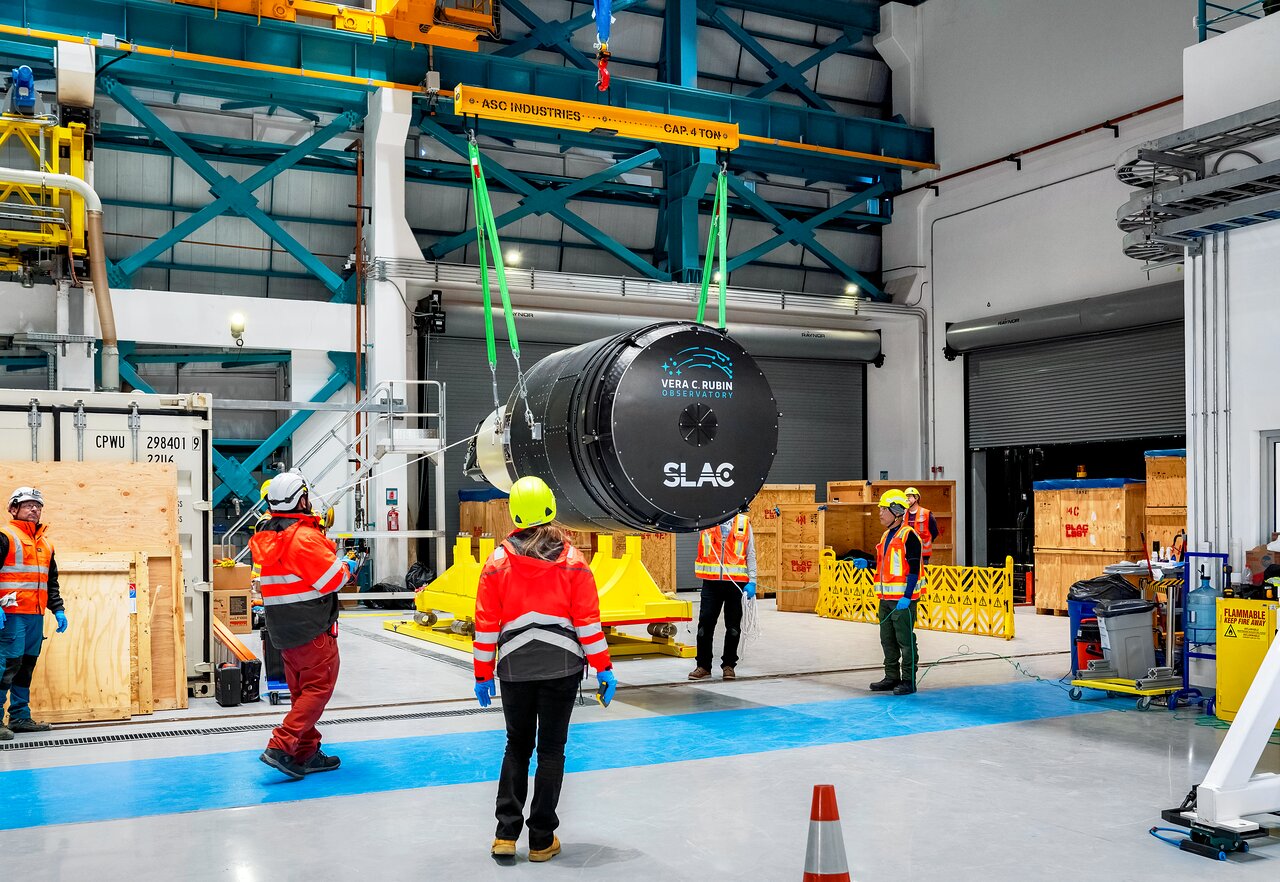
22 May 2024-------------- noirlab 2413
After two decades of work, the 3200-megapixel LSST Camera is finally on-site at Vera C. Rubin Observatory
The largest camera ever built for astrophysics has completed the long journey from SLAC National Accelerator Laboratory in California to the summit of Cerro Pachón in Chile, where it will soon help unlock the mysteries of the Universe.
The 3200-megapixel LSST Camera, the groundbreaking instrument at the core of the NSF–DOE Vera C. Rubin Observatory, has arrived at the observatory site on Cerro Pachón in Chile. The LSST Camera is funded by the U.S. Department of Energy’s Office of Science (DOE/SC), and the NSF–DOE Vera C. Rubin Observatory is funded by the U.S. National Science Foundation (NSF) and the DOE/SC. When Rubin begins the Legacy Survey of Space and Time (LSST) in late 2025, the LSST Camera will take detailed images of the southern hemisphere sky for 10 years, building the most comprehensive timelapse view of our Universe we’ve ever seen. “The arrival of the cutting-edge LSST Camera in Chile brings us a huge step closer to science that will address today’s most pivotal questions in astrophysics,” said Kathy Turner, DOE’s Program Manager for Rubin Observatory.
The LSST Camera — the largest digital camera in the world — was built at SLAC National Accelerator Laboratory in Menlo Park, California, and its completion after two decades of work was announced by SLAC early in April. This incredibly sensitive camera will soon be installed on the Simonyi Survey Telescope at Rubin Observatory, where it will produce detailed images with a field of view seven times wider than the full Moon. Using the LSST Camera, Rubin Observatory will fuel advances — and brand new discoveries — in many science areas, including exploring the nature of dark matter and dark energy, mapping the Milky Way, surveying our Solar System, and studying celestial objects that change in brightness or position.
“Getting the camera to the summit was the last major piece in the puzzle,” said Victor Krabbendam, Project Manager for Rubin Observatory Construction. “With all Rubin’s components physically on site, we’re on the home stretch towards transformative science with the LSST.”
The LSST Camera team at SLAC led the process of shipping the car-sized camera from California to Chile. The camera’s shipping container was outfitted with data loggers, both on the camera frame and on the container itself, to monitor temperature, humidity, vibration, and accelerations throughout the trip. A GPS tracking system was installed on the container so the team could pinpoint the camera’s location at any point on the journey.
The LSST Camera, secure in its container, traveled on an air-ride-equipped transport vehicle to San Francisco airport on the morning of 14 May for a chartered flight to Chile. After the camera was carefully loaded on the Boeing 747 cargo plane two LSST Camera team members boarded the plane and settled into their seats for the 10-hour flight to Chile. “We were uncertain about the ‘jump seats’ we were promised on board, but they turned out to be plenty comfortable, and having two engineers on the plane was critical for loading and unloading,” said Travis Lange, LSST Camera Project Manager. “The entire process was also incredibly exciting!”
The plane landed at 4:10 a.m. on 15 May at Arturo Merino Benítez Airport in Santiago, the closest airport to the observatory that could accommodate a cargo plane of this size. By that evening the camera was inside the guarded gate at the base of Cerro Pachón. The next morning, the vehicle carrying the camera began the 35-kilometer (21.7-mile) drive up to the summit, accompanied by pilot and tail cars. Driving slowly and carefully on the winding dirt road, the camera truck reached the summit in about five hours.
Upon its arrival at the observatory building, the camera was unloaded immediately into the receiving area on the third level and moved into the observatory’s white room, which offers a controlled environment with no airborne contaminants. There it was inspected by the Rubin Observatory Commissioning Team and pronounced visibly intact. The team also downloaded the data from the data loggers and verified that the camera hadn’t encountered any unexpected stresses. “Our goal was to make sure the camera not only survived, but arrived in perfect condition,” said Kevin Reil, Observatory Scientist at Rubin. “Initial indications — including the data collected by the data loggers, accelerometers, and shock sensors — suggest we were successful.”
The LSST Camera is the final major component of Rubin Observatory’s Simonyi Survey Telescope to arrive at the summit, and after several months of testing in the observatory’s white room, the camera will be installed on the telescope along with Rubin’s newly-coated 8.4-meter mirror and 3.4-meter secondary mirror. Stay tuned for updates in the coming months as the LSST Camera — and Rubin Observatory — get closer to carrying out their transformative mission.
Rubin Observatory is a Program of NSF NOIRLab, which, along with DOE's SLAC National Accelerator Laboratory, will jointly operate Rubin.
